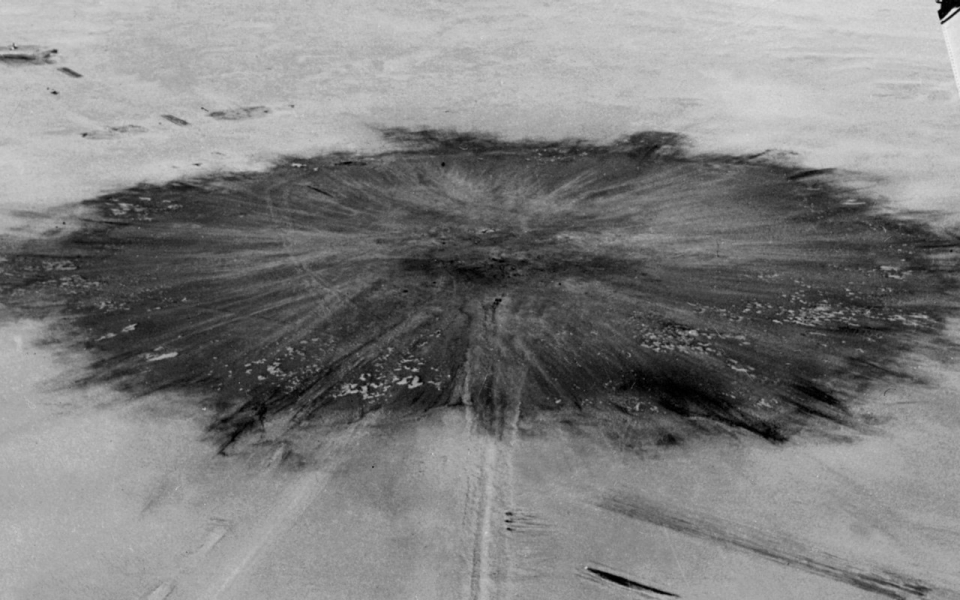Fifty five years after France’s nuke tests, Saharan residents still struggle with cancers, blindness and birth defects, while Compensation scheme has aided very few victims, Johnny Magdaleno wrote for Al-Jazeera.
Algerians were not properly warned of the dramatic danger after France’s misgoverned nuclear bomb-testing campaign of the early 1960s, which vitrified vast tracts of desert with heat and plutonium and left a legacy of uncontained radiation that is still crippling inhabitants. Estimates of the number of Algerians affected by testing range from 27,000 — cited by the French Ministry of Defense — to 60,000, the figure given by Abdul Kadhim al-Aboudi, an Algerian professor of nuclear physics.
Yet there has been little accountability for France’s disregard. A compensation scheme for victims of France’s nuclear tests exists, but it has made payouts to only 17 people. The majority of those were residents of French Polynesia, where France relocated its nuclear testing campaign after leaving Algeria and experimented with more than 190 nuclear bombs from 1966 to 1996.
Hiroshima-Like Bombing
France tested its first nuclear bomb in the Tanezrouft area, a portion of the Sahara that straddles Algeria and Mali, some 50 kilometers south of Reggane, on Feb. 13, 1960. Named Gerboise Bleue (“blue jerboa”) after the left hue of the tricolor French flag and a small rodent living in the Sahara, it had a blast capacity of 70 kilotons — or more than four times the strength of Little Boy, the US bomb dropped on Hiroshima at the end of World War II. In two years, the French tested four bombs aboveground in Tanezrouft. But even after Algeria’s independence from France in 1962, at the end of an eight-year revolutionary war that left hundreds of thousands dead, the French maintained a military presence in the region and tested 13 nuclear bombs underground, in a facility beneath the Hoggar mountains, 400 miles southeast of Reggane.
When France finally left, it buried a range of contaminated objects throughout the two areas — metal from remote-controlled towers that activated the bombs, engine parts from planes that flew into Gerboise Bleue’s mushroom cloud to gather radiation data and military-grade trucks placed in the blast radius to act as barometers of its power. But Saharan winds later swept away the sand covering these nuclear tombs. Southern Algerians — the vast majority of whom were never informed by the French about residual radiation hazards and in some cases the testing dates — began stripping the items for resources.
A Criminal Act
“The fact that people were not aware of the dangers of this material for years is criminal,” said Larbi Benchiha, a French-Algerian journalist who was born in Algeria a year before Gerboise Bleue and has made two documentaries on Reggane and the surrounding areas. Benchiha did not learn about the nuclear tests until 1996 — 16 years after he moved to France. “From the abandoned nuclear testing bases, people have recovered plates, beams, electrical cables and equipment of all kinds, all of which is radioactive,” he continued. “They have incorporated them into the construction of their homes.”
Residents of Reggane told Benchiha about the strange uptick of medical issues that first appeared during the 1970s and continue to this day. Babies born with atrophied limbs; cancers of the liver, stomach and skin; cases of temporary blindness among those who saw the brutal flash of light as it ripped through the Maghreb about 6:30 a.m. Some of Reggane’s faithful were in the middle of their morning prayers when it happened 55 years ago.
Heinous Silence
The French government has remained relatively quiet on the matter, even as criticism of the country’s disregard for safe nuclear containment practices mounted in France, Algeria and abroad. Algerian nuclear energy expert Ammar Mansouri described the tests as “the most despicable crimes perpetrated by colonial France in Algeria” during a conference in the capital, Algiers. He demanded that France, which signed a retroactive International Atomic Energy Association treaty on radioactive waste management in 1997, face international law.
In 2010 administrative progress was made when the French National Assembly approved a compensation plan for victims of its nuclear testing campaigns in Algeria and French Polynesia, which set aside approximately $11 million to be divided among recipients. Modest estimates suggest that since 1960, at least 150,000 people have lived in, near or traveled through areas where France has tested atomic arms.


